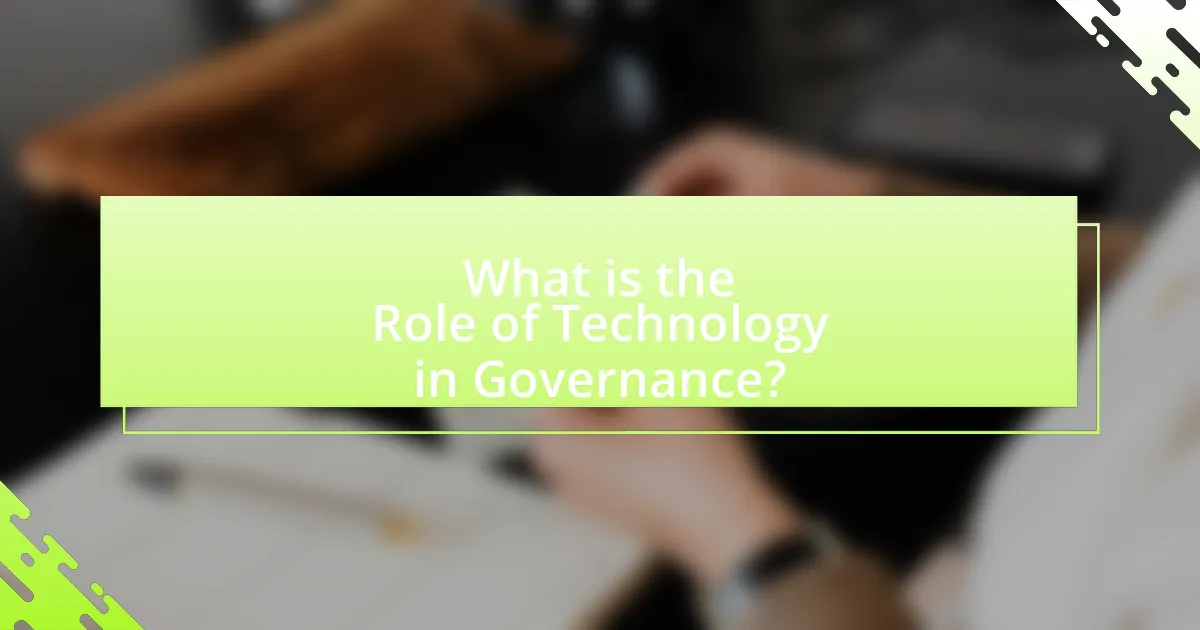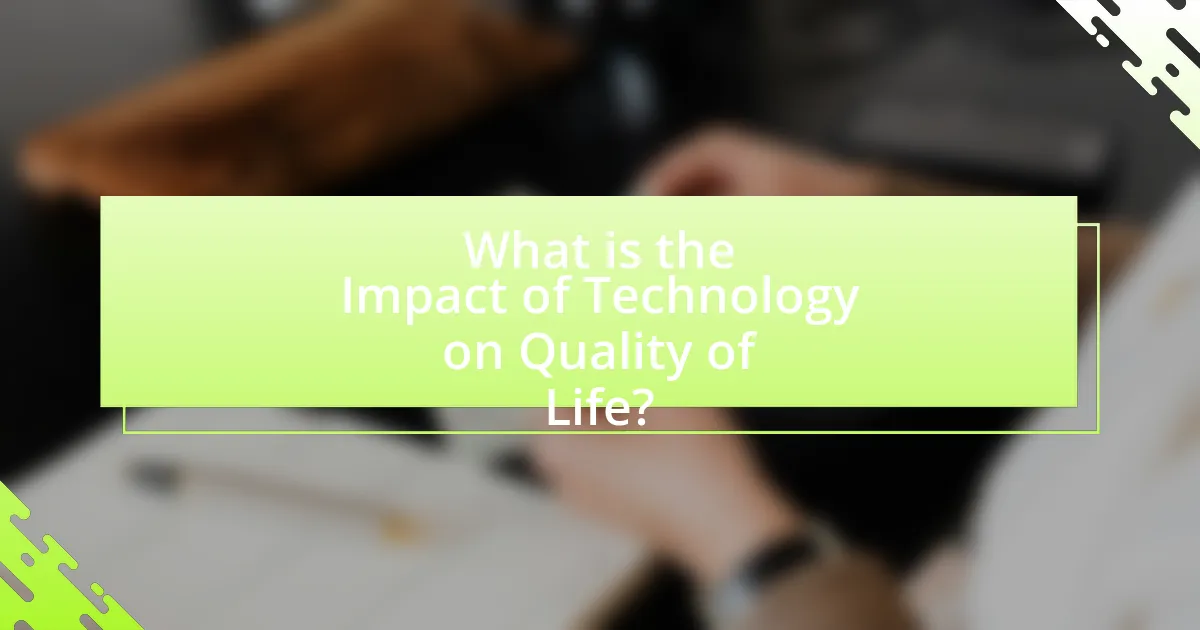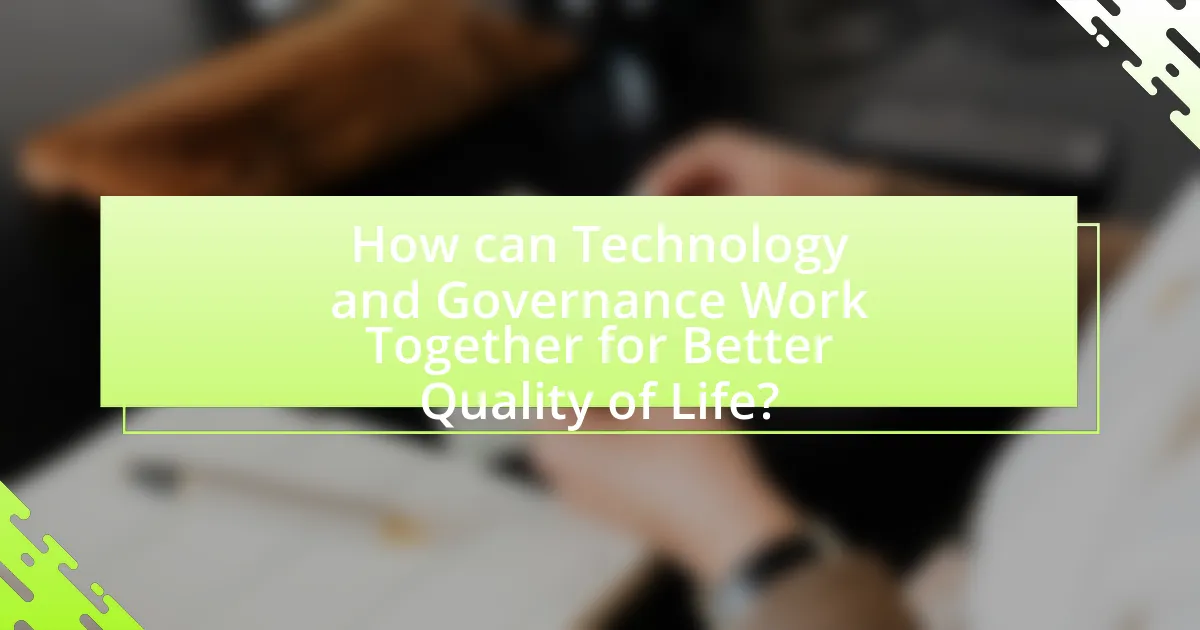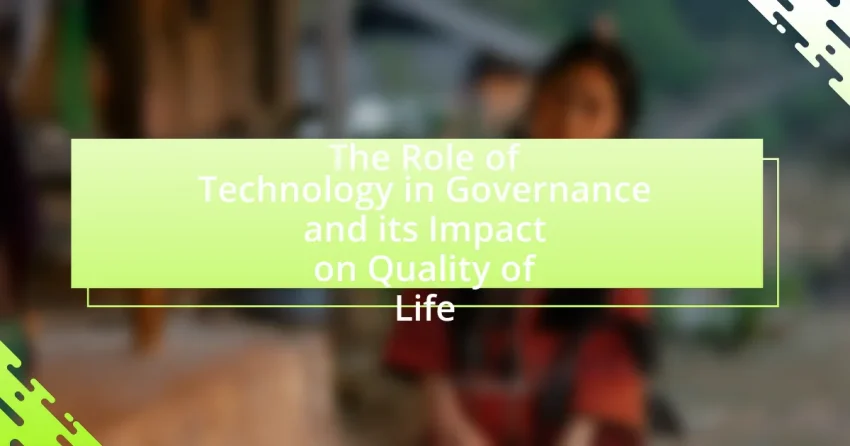The article examines the critical role of technology in governance and its significant impact on quality of life. It highlights how technology enhances transparency, efficiency, and citizen engagement through e-governance initiatives, data analytics, and artificial intelligence. Key technologies such as blockchain and cloud computing are discussed for their contributions to decision-making and service delivery. The article also addresses challenges in technology adoption, potential drawbacks, and strategies for ensuring equitable access, ultimately emphasizing the importance of technology in improving governance and citizen satisfaction.

What is the Role of Technology in Governance?
Technology plays a crucial role in governance by enhancing transparency, efficiency, and citizen engagement. It enables governments to streamline processes, improve service delivery, and facilitate communication between officials and the public. For instance, e-governance initiatives, such as online portals for public services, have been shown to reduce bureaucratic delays and increase accessibility, as evidenced by the implementation of digital platforms in countries like Estonia, which ranks highly in digital governance. Furthermore, data analytics and artificial intelligence are increasingly used to inform policy decisions, optimize resource allocation, and predict social trends, thereby improving overall governance effectiveness.
How does technology influence decision-making in governance?
Technology significantly influences decision-making in governance by enhancing data accessibility and improving communication efficiency. Digital tools enable governments to collect, analyze, and disseminate vast amounts of data, which informs policy decisions and resource allocation. For instance, the use of big data analytics allows for evidence-based decision-making, as seen in cities like New York, where data-driven approaches have improved public safety and urban planning. Additionally, technology facilitates real-time communication between government officials and citizens, fostering transparency and accountability. The implementation of e-governance platforms has streamlined processes, reducing bureaucratic delays and increasing citizen engagement in governance.
What are the key technologies used in governance?
Key technologies used in governance include blockchain, artificial intelligence (AI), big data analytics, and cloud computing. Blockchain enhances transparency and security in transactions, as evidenced by its use in voting systems to prevent fraud. AI improves decision-making processes by analyzing vast amounts of data, which has been shown to optimize resource allocation in public services. Big data analytics allows governments to gather insights from citizen data, leading to more informed policy-making, as demonstrated in smart city initiatives. Cloud computing provides scalable infrastructure for government services, facilitating efficient data management and accessibility.
How do these technologies improve transparency and accountability?
Technologies such as blockchain, data analytics, and digital platforms enhance transparency and accountability by providing immutable records, real-time data access, and open communication channels. Blockchain technology ensures that transactions are recorded in a secure and tamper-proof manner, making it difficult for any party to alter information without detection. For instance, in public procurement, blockchain can track the entire process, allowing stakeholders to verify each step and ensuring that funds are used appropriately. Data analytics enables governments to analyze large datasets, revealing patterns and insights that can hold officials accountable for their actions. Additionally, digital platforms facilitate direct communication between citizens and government entities, allowing for feedback and reporting of issues, which fosters a culture of accountability. These technologies collectively create an environment where information is accessible, and actions can be scrutinized, thereby reinforcing trust in governance.
Why is technology adoption important for modern governance?
Technology adoption is crucial for modern governance because it enhances efficiency, transparency, and citizen engagement. By integrating digital tools, governments can streamline processes, reduce bureaucratic delays, and improve service delivery. For instance, the implementation of e-governance platforms has been shown to decrease administrative costs by up to 30% while increasing public access to services. Furthermore, technology fosters transparency through open data initiatives, allowing citizens to track government spending and decision-making, which can lead to increased trust in public institutions. Studies indicate that countries with higher levels of technology adoption in governance experience greater citizen participation in democratic processes, ultimately improving the quality of life.
What challenges do governments face in adopting new technologies?
Governments face several challenges in adopting new technologies, including budget constraints, resistance to change, and the need for skilled personnel. Budget constraints limit the financial resources available for technology investments, making it difficult to implement and maintain new systems. Resistance to change often arises from bureaucratic inertia and fear of job displacement, hindering the adoption process. Additionally, the lack of skilled personnel can impede the effective integration of new technologies, as governments may struggle to find or train employees with the necessary expertise. According to a report by the OECD, 70% of public sector organizations cite skills shortages as a significant barrier to digital transformation.
How can governments overcome these challenges?
Governments can overcome challenges in governance by implementing advanced technologies such as artificial intelligence and data analytics to enhance decision-making processes. For instance, the use of AI can streamline public services, improve resource allocation, and facilitate real-time data analysis, leading to more efficient governance. A study by the McKinsey Global Institute found that AI could potentially create an additional $13 trillion in global economic activity by 2030, demonstrating the significant impact technology can have on governance efficiency. Additionally, fostering public-private partnerships can drive innovation and provide access to cutting-edge technologies, further enabling governments to address complex societal issues effectively.

What is the Impact of Technology on Quality of Life?
The impact of technology on quality of life is significant, enhancing convenience, accessibility, and communication. Technology facilitates instant access to information, improving education and healthcare outcomes; for instance, telemedicine has increased healthcare access for remote populations, leading to better health management. Additionally, smart home devices contribute to energy efficiency and safety, while social media platforms foster connections, reducing feelings of isolation. According to a 2020 Pew Research study, 81% of Americans feel technology has improved their lives, highlighting its positive influence on daily experiences and overall well-being.
How does technology enhance public services?
Technology enhances public services by improving efficiency, accessibility, and transparency. For instance, the implementation of digital platforms allows citizens to access government services online, reducing wait times and streamlining processes. According to a report by the United Nations, e-government initiatives have led to a 20% increase in citizen satisfaction due to faster service delivery and improved communication channels. Additionally, data analytics enables governments to make informed decisions, optimizing resource allocation and enhancing service delivery. This integration of technology not only fosters greater public engagement but also promotes accountability within government operations.
What specific services have improved due to technology?
Healthcare services have significantly improved due to technology. The integration of telemedicine allows patients to consult healthcare professionals remotely, enhancing access to medical care, especially in rural areas. According to a study published in the Journal of Medical Internet Research, telehealth services increased by 154% during the COVID-19 pandemic, demonstrating their effectiveness in maintaining healthcare delivery. Additionally, electronic health records (EHRs) streamline patient information management, improving coordination among healthcare providers and reducing errors. A report from the Office of the National Coordinator for Health Information Technology indicates that EHR adoption has reached over 85% among hospitals, showcasing the widespread impact of technology on healthcare services.
How does technology facilitate citizen engagement and participation?
Technology facilitates citizen engagement and participation by providing platforms for communication, information sharing, and feedback mechanisms. Digital tools such as social media, mobile applications, and online forums enable citizens to express their opinions, access government services, and participate in decision-making processes. For instance, a study by the Pew Research Center found that 69% of adults in the U.S. use social media, which serves as a vital channel for civic engagement and mobilization. Additionally, e-governance initiatives, like online voting and public consultations, enhance transparency and accountability, allowing citizens to engage directly with their government. These technological advancements not only streamline communication but also empower citizens to influence policies and contribute to their communities effectively.
What are the potential drawbacks of technology in governance?
The potential drawbacks of technology in governance include increased surveillance, data privacy concerns, and the risk of digital divide. Increased surveillance can lead to a loss of civil liberties, as governments may monitor citizens more closely through technology. Data privacy concerns arise when sensitive information is collected and stored, making it vulnerable to breaches or misuse. Additionally, the digital divide can exacerbate inequalities, as marginalized populations may lack access to the necessary technology or digital literacy to engage with government services effectively. These drawbacks highlight the need for careful consideration and regulation of technology in governance to protect citizens’ rights and ensure equitable access.
How can technology lead to inequality in access to services?
Technology can lead to inequality in access to services by creating a digital divide where certain populations lack the necessary resources or skills to utilize technological advancements. For instance, individuals in low-income areas may not have access to high-speed internet or modern devices, limiting their ability to access online services such as education, healthcare, and government resources. According to a report by the Pew Research Center, as of 2021, 27% of lower-income households in the United States did not have broadband internet, which directly impacts their ability to engage with essential services that are increasingly offered online. This disparity in access reinforces existing socioeconomic inequalities, as those without technology are further marginalized from opportunities and resources that are readily available to others.
What measures can be taken to mitigate these drawbacks?
To mitigate the drawbacks of technology in governance, implementing robust cybersecurity measures is essential. Cybersecurity protocols protect sensitive data from breaches, ensuring that citizens’ information remains secure and fostering trust in digital governance systems. Additionally, promoting digital literacy among citizens can empower them to navigate technology effectively, reducing the risk of misinformation and enhancing public engagement. Research indicates that countries with higher levels of digital literacy experience improved governance outcomes, as informed citizens are more likely to participate in democratic processes. Furthermore, establishing transparent policies regarding data usage and privacy can alleviate concerns about surveillance and misuse of information, thereby enhancing public confidence in technological initiatives.

How can Technology and Governance Work Together for Better Quality of Life?
Technology and governance can work together to enhance the quality of life by improving public service delivery, increasing transparency, and fostering citizen engagement. For instance, the implementation of e-governance platforms allows citizens to access government services online, reducing wait times and increasing efficiency. According to a report by the United Nations, countries that have adopted digital governance strategies have seen a 20% increase in citizen satisfaction due to improved service accessibility. Additionally, technology such as data analytics enables governments to make informed decisions based on real-time data, leading to better resource allocation and policy-making. This synergy between technology and governance ultimately results in a more responsive and accountable government, which directly contributes to an improved quality of life for citizens.
What best practices can be implemented for effective technology use in governance?
Effective technology use in governance can be achieved through best practices such as ensuring transparency, fostering citizen engagement, and implementing robust cybersecurity measures. Transparency can be enhanced by utilizing open data platforms, which allow citizens to access government data, thereby promoting accountability; for instance, the U.S. government’s Data.gov initiative provides public access to a wealth of datasets. Citizen engagement can be improved through digital platforms that facilitate public consultations and feedback, exemplified by participatory budgeting tools used in cities like Paris, which empower residents to influence budget allocations. Additionally, robust cybersecurity measures are essential to protect sensitive information and maintain public trust; the National Institute of Standards and Technology (NIST) provides guidelines that help governments establish effective cybersecurity frameworks. These practices collectively contribute to more effective governance and improved quality of life for citizens.
How can governments ensure equitable access to technological advancements?
Governments can ensure equitable access to technological advancements by implementing policies that promote digital inclusion and infrastructure development. For instance, investing in broadband internet access in underserved areas can bridge the digital divide, as evidenced by the Federal Communications Commission’s 2020 report, which highlighted that 14.5 million Americans lack access to high-speed internet. Additionally, providing subsidies or incentives for low-income households to access technology can enhance affordability and usage. Programs like the Lifeline program in the United States, which offers discounted phone and internet services to eligible low-income consumers, demonstrate effective strategies for increasing access. Furthermore, governments can foster partnerships with private sector companies to develop affordable technology solutions tailored to the needs of marginalized communities, ensuring that advancements benefit all citizens equitably.
What role do public-private partnerships play in enhancing governance through technology?
Public-private partnerships (PPPs) significantly enhance governance through technology by facilitating collaboration between government entities and private sector organizations to deliver innovative solutions. These partnerships leverage the expertise, efficiency, and resources of the private sector to improve public services, streamline processes, and implement advanced technologies such as data analytics and digital platforms. For instance, the implementation of smart city initiatives often relies on PPPs to integrate IoT technologies for better urban management, resulting in improved public safety and resource allocation. Evidence of this effectiveness can be seen in cities like Barcelona, where PPPs have led to enhanced citizen engagement and service delivery through digital platforms, demonstrating a measurable increase in quality of life indicators.
What are the future trends in technology and governance?
Future trends in technology and governance include the increased adoption of artificial intelligence, blockchain technology, and data analytics to enhance transparency and efficiency in public administration. Governments are increasingly utilizing AI for decision-making processes, which can lead to more informed policies and improved service delivery. Blockchain technology is being explored for secure voting systems and transparent public records, thereby reducing fraud and increasing trust in governance. Additionally, data analytics is being leveraged to analyze citizen feedback and optimize resource allocation, ultimately improving the quality of life for citizens. These trends are supported by various studies, including a 2021 report by the World Economic Forum, which highlights the potential of these technologies to transform governance and enhance citizen engagement.
How might emerging technologies reshape governance in the coming years?
Emerging technologies will reshape governance by enhancing transparency, efficiency, and citizen engagement. For instance, blockchain technology can provide immutable records of government transactions, reducing corruption and increasing public trust. Additionally, artificial intelligence can streamline administrative processes, allowing for quicker decision-making and resource allocation. A study by the McKinsey Global Institute indicates that AI could improve public sector productivity by up to 20%, demonstrating its potential impact on governance. Furthermore, digital platforms enable greater citizen participation in policy-making, fostering a more inclusive governance model. These advancements collectively indicate a significant transformation in how governments operate and interact with their constituents.
What skills will be necessary for future governance professionals in a tech-driven environment?
Future governance professionals in a tech-driven environment will need skills in data analysis, digital literacy, cybersecurity, and ethical decision-making. Data analysis is crucial for interpreting large datasets to inform policy decisions, as evidenced by the increasing reliance on data-driven governance models. Digital literacy enables professionals to effectively utilize technology tools and platforms for communication and engagement with citizens. Cybersecurity skills are essential to protect sensitive information and maintain public trust, especially as cyber threats grow. Ethical decision-making is vital to navigate the complexities of technology’s impact on society, ensuring that governance practices uphold democratic values and human rights.
What practical steps can citizens take to engage with technology in governance?
Citizens can engage with technology in governance by utilizing digital platforms for participation, such as online petitions, e-governance portals, and social media channels. These platforms allow citizens to voice their opinions, access government services, and participate in decision-making processes. For instance, a study by the Pew Research Center found that 70% of Americans believe that technology improves their ability to engage with government. Additionally, citizens can attend virtual town hall meetings and use mobile applications designed for civic engagement, which facilitate direct communication with elected officials and enhance transparency in governance.
